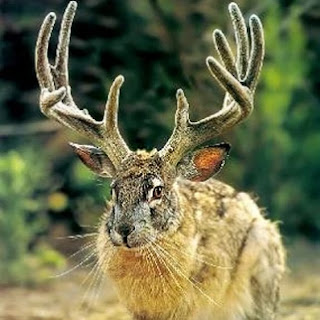🐰Jackalope🐰
The Jackalope is a rabbit like cryptid with small deer like antlers, many cultures describe a similar beast but the most widely know is the North American Jackalope.
During the wild west days cowbows claimed that it could be heard mimicking their voices.
It's said the a Jackalope could be captured by putting a flask of whiskey out at night.
The Jackalope will drink its fill of whiskey and its intoxication will make it easier to hunt.
Some claim that Jackalope meat has a taste similar to lobster, However, legend says they are dangerous if approached.
A Jackalope is rare because they only breed during electrical storms including hail.
................................
The town of Douglas, Wyoming, has declared itself to be the Jackalope capital of America because, according to legend, the first Jackalope was spotted there around 1829.
A large statue of a Jackalope stands in the town center, and every year the town plays host to Jackalope Day, usually held in June.
Jackalope hunting licenses can be obtained from the Douglas Chamber of Commerce, though the hunting of Jackalopes is restricted to the hours of 12:00 am to 2:00 am on June 31.
According to the Douglas Chamber of Commerce, a 1930s hunting trip for jackrabbits led to the idea of a Jackalope. Herrick and his brother had studied taxidermy by mail order as teenagers. When the brothers returned from a hunting trip, Herrick tossed a jackrabbit carcass into the taxidermy store, where it came to rest beside a pair of deer antlers. The accidental combination of animal forms sparked Douglas Herrick’s idea for a Jackalope.
That first Jackalope was sold for $10 to Roy Ball, who installed it proudly in the town's Bonte Hotel. The mounted horned jackrabbit head was stolen in 1977.
Other versions of teh jackolope
Germany
The Wolpertinger
t has a body comprising various animal parts – generally wings, antlers, a tail, and fangs; all attached to the body of a small mammal. The most widespread description portrays the Wolpertinger as having the head of a rabbit, the body of a squirrel, the antlers of a deer, and the wings and occasionally the legs of a pheasant
..........
The rasselbock or rarely raspelbock It has the head and body of a rabbit, and the antlers of a roe deer. The female counterpart of the rasselbock is the Rasselgeiß, which have smaller antlers. Some rasselbocks have been known to be shown with canine teeth, unlike other hares and rabbits. The young animals are called Waldrasslinge.
...........................
The skvader (pronounced [ˈskvɑ̌ːdɛr]) is a Swedish fictional creature that was constructed in 1918 by the taxidermist Rudolf Granberg and is permanently displayed at the museum at Norra Berget in Sundsvall. It has the forequarters and hindlegs of a European hare (Lepus europaeus), and the back, wings and tail of a female wood grouse
.......................................
Al-Mi'raj or Almiraj (Arabic: ٱلْمِعْرَاج; al-miʿrāj) is a mythical creature resembling a one-horned rabbit t, from medieval Arabic literature.
..................................
The Lepus Cornutus
Horned rabbits were also described in medieval and early Renaissance texts, both as real creatures and as mythological ones.
Rabelais in his Gargantua and Pantagruel. first mentioned the lepus cornutus was described as a real animal.
Conrad Gessner in his Historiae animalium, mentioning that they live in Saxony.
Many other scientific works on animals repeated this or similar claims, often with the same depictions. These include John Jonston's Historiae naturalis de quadrupetibus libri from 1655, whose illustrations were reused in e.g. the 1718 Theatrum universale omnium animalium, piscium, avium, quadrupedum, exanguium, aquaticorum, insectorum et angium by Ruysch.
Gaspar Schott wrote about the horned hare in his 1662 work Physica curiosa, displaying it on the frontispice and with a further illustration.
Gabriel Clauder published in 1687 an article on a horned hare he had sighted, with an illustration. In 1743, Jacob Theodor Klein in his Summa dubiorum produced another illustration of the same.
Pierre Joseph Bonnaterre's 1789 Tableau Encyclopedique et Methodique was apparently the last major scientific work to include the lepus cornutus as a real animal. By the late 18th and early 19th century, the idea of a horned hare as a real species was mostly rejected, although the 1817 Nouveau dictionnaire d'histoire naturelle considers it a possibly real but very rare animal.









No comments:
Post a Comment